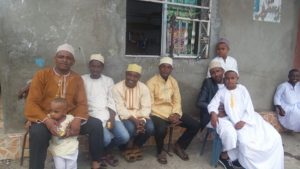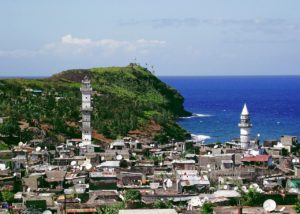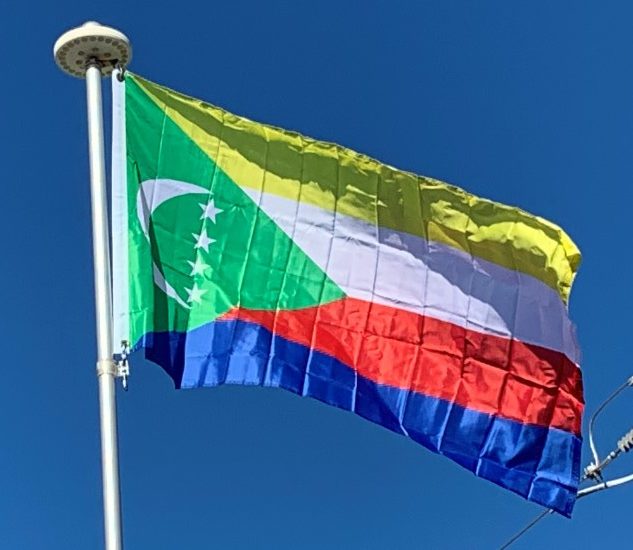The islands of the Comoros were populated by a succession of peoples from the coast of Africa, the Arabian Peninsula and the Persian Gulf, the Malay Archipelago, and Madagascar. Bantu-speaking settlers reached the islands as a part of the greater Bantu expansion that took place in Africa throughout the first millennium.

According to pre-Islamic mythology, a jinni (spirit) dropped a jewel, which formed a great circular inferno. This became the Karthala volcano, which created the island of Grande Comoro.
Development of the Comoros is divided into phases. The earliest reliably recorded phase is the Dembeni phase (ninth to tenth centuries), during which each island maintained a single, central village. From the eleventh to the fifteenth centuries, trade with the island of Madagascar and merchants from the Middle East flourished, smaller villages emerged, and existing towns expanded. Many Comorians can trace their genealogies to ancestors from Yemen, mainly Hadhramaut, and Oman.
Medieval Comoros:
According to legend, in 632, upon hearing of Islam, islanders are said to have dispatched an emissary, Mtswa-Mwindza, to Mecca—but by the time he arrived there, the Prophet Muhammad had died. Nonetheless, after a stay in Mecca, he returned to Ngazidja and led the gradual conversion of his islanders to Islam.
Among the earliest accounts of East Africa, the works of Al-Masudi describe early Islamic trade routes, and how the coast and islands were frequently visited by Muslims including Persian and Arab merchants and sailors in search of coral, ambergris, ivory, tortoiseshell, gold and slaves. They also brought Islam to the people of the Zanj including the Comoros. As the importance of the Comoros grew along the East African coast, both small and large mosques were constructed. Despite its distance from the coast, the Comoros is situated along the Swahili Coast in East Africa. It was a major hub of trade and an important location in a network of trading towns that included Kilwa, in present-day Tanzania, Sofala (an outlet for Zimbabwean gold), in Mozambique, and Mombasa in Kenya.

After the arrival of the Portuguese in the early 15th century and subsequent collapse of the East African sultanates, the powerful Omani Sultan Saif bin Sultan began to defeat the Dutch and the Portuguese. His successor Said bin Sultan increased Omani Arab influence in the region, moving his administration to nearby Zanzibar, which came under Omani rule. Nevertheless, the Comoros remained independent, and although the three smaller islands were usually politically unified, the largest island, Ngazidja, was divided into a number of autonomous kingdoms.
By the time Europeans showed interest in the Comoros, the islanders were well placed to take advantage of their needs, initially supplying ships of the route to India and, later, slaves to the plantation islands in the Mascarenes.
European Contact and French Colonization:
Portuguese explorers first visited the archipelago in 1503. The islands provided provisions to the Portuguese fort at Mozambique throughout the 16th century.
In 1793, Malagasy warriors from Madagascar first started raiding the islands for slaves. On the Comoros, it was estimated in 1865 that as much as 40% of the population consisted of slaves. France first established colonial rule in the Comoros in 1841. The first French colonists landed in Mayotte, and Andriantsoly (also known as Andrian Tsouli, the Sakalava Dia-Ntsoli, the Sakalava of Boina, and the Malagasy King of Mayotte) signed the Treaty of April 1841, which ceded the island to the French authorities.
